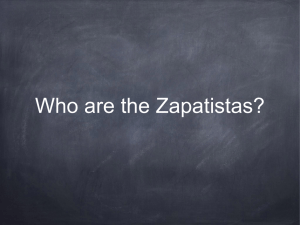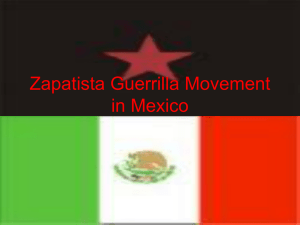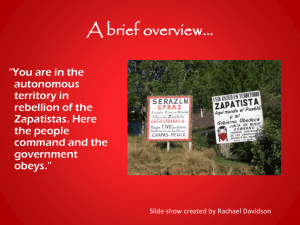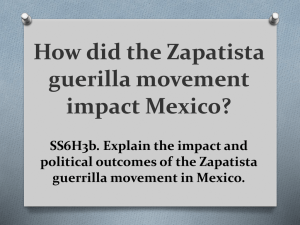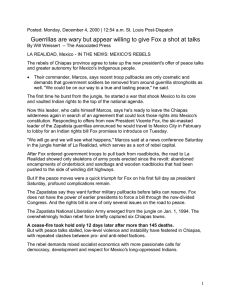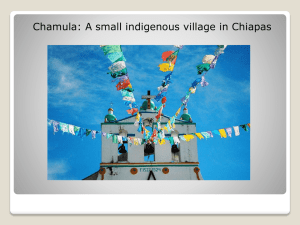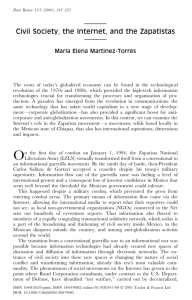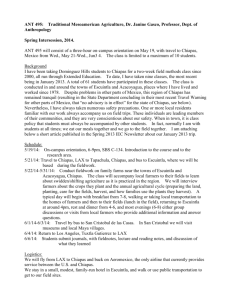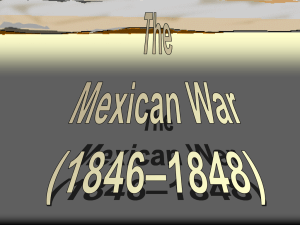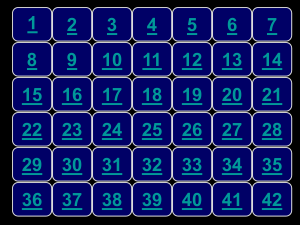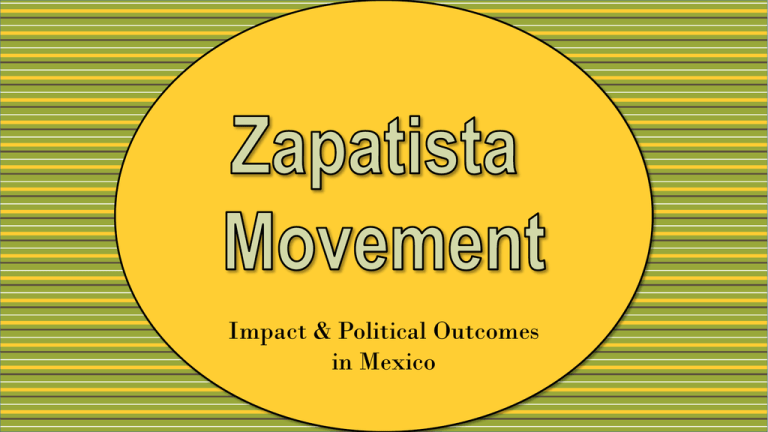
Impact & Political Outcomes
in Mexico
Standards
SS6H3 The student will analyze important 20th century issues
in Latin America and the Caribbean.
b. Explain the impact and political outcomes of the Zapatista
guerrilla movement in Mexico.
Teachers – Picture Analysis Activity
Put the students into six groups, and give each group one of the following pictures.
Have the students look at the picture and make predictions about what is happening
in the picture. The students should complete the Picture Analysis handout. Have the
groups share their picture & answers with the class. After all pictures have been
shared, have the class make a prediction about who the Zapatistas are and what they
are fighting for.
*All of the pictures are of the Zapatistas. I have found that most students know
nothing about this organization, so the Picture Analysis has been a good way to spark
their interest in the topic, especially after they see the masked men and weapons.
Teachers
Print off the following page for each student.
They should complete the graphic organizer
while discussing the presentation.
Impact & Political Outcomes
in Mexico
• They are generally small military groups that are
made up of non-traditional soldiers.
• These groups do not represent an entire country,
but rather a common cause or idea.
• Guerillas use surprise attacks and sabotage (known as
“guerilla warfare”) to attack their enemies.
• The Zapatistas are a guerilla group who support
improved rights and living conditions for Mexico’s
indigenous (native) people.
• The group consists primarily of poor farmers
and workers of indigenous American ancestry.
• The Zapatistas get their name from one of the
leaders of the Mexican Revolution, Emiliano
Zapata.
• Zapata is a Mexican symbol for rising up
against a government that oppresses the
people.
• Zapata did not create the Zapatistas, but his
lifetime achievements inspired the name of the
group.
• The Zapatistas are located in the Chiapas region
of southern Mexico.
• Chiapas is a resource-rich state.
• It produces over half of Mexico’s hydroelectric
power.
• It’s the 2nd largest petroleum-producing state.
• It’s the largest coffee exporting state.
• Chiapas has the worst rates of poverty in Mexico.
• Three-fourths of its people are malnourished.
• Over half live in dwellings with dirt floors.
• 19% of the population has no income.
• 39% earn less than minimum wage ($3 per day).
• Chiapas is a huge contributor to the global economy (water, oil,
etc.), but its people are getting very little in return.
• There is a huge division between the rich and the poor in the
state.
Leader of Zapatistas
Subcomandante Marcos
"The natural wealth that leaves these
lands doesn't travel over just these
three roads (leading to Chiapas).
Chiapas is bled through thousands of
veins: through oil ducts and gas ducts,
over electric wires, by railroad cars,
through bank accounts, by trucks and
vans, by ships and planes...And what
tribute does this land continue to pay
to various empires? Oil, electric
energy, cattle, money, bananas, honey,
corn, cocoa, tobacco, sugar, soy...and
Chiapan blood flows out through a
thousand and one fangs sunk into the
neck of southeastern Mexico."
• The Zapatistas want to eliminate the division between
the social classes in Chiapas (wealthy vs. poor).
• They feel that the indigenous people of Mexico need
more help to improve healthcare, housing, education,
and jobs.
• They have tried to peacefully negotiate with Mexico’s
government, but those agreements have not solved the
peoples’ problems…
Chiapas Roadside Sign:
“You are in Zapatista
rebel territory. Here
the people command
and the government
obeys.”
• In 1994, the North American Free Trade Agreement came into
effect and allowed free trade between US, Canada, and Mexico.
• Some people in Mexico did not like this plan:
• They believed that NAFTA would allow cheap farm goods to
come into Mexico from the US.
• They felt NAFTA benefitted the wealthy and hurt the poor
Native American farmers by lowering prices of crops like coffee
and corn.
• They feared that farmers in Mexico would not be able to
compete with the cheaper food.
• On the day NAFTA took effect, the Zapatistas used
guerilla tactics and took over seven towns in their part
of Mexico (state of Chiapas).
• The Mexican army was sent in to remove the Zapatistas.
• Fighting lasted for several weeks until a cease-fire
eventually ended it.
Armed Takeover in Chiapas – 1994
• Even though the 1994 revolt was put down by the Mexican
National Army, the Zapatistas did not go away.
• They received recognition from governments worldwide, and
the revolt helped put pressure on the Mexican government to
fix the problems in the Chiapas region.
• The Mexican government and the Zapatistas are working
constantly to come up with solutions in Chiapas.
• The Zapatistas want more money and assistance from the
government in helping to make the Chiapas region a better
place to live.
• It’s taking a long time…
Teachers
Thank you for downloading this file. I hope you enjoy using it with your students, and
I can’t wait to read your feedback in my TPT store!
• For more social studies materials, please visit my store:
http://www.teacherspayteachers.com/Store/Brain-Wrinkles
• I teach Language Arts and Social Studies in Georgia, so my products are aligned
with Common Core (LA) and Georgia Performance Standards (SS).
© Copyright 2013. Brain Wrinkles. All rights reserved. Permission is granted to copy pages specifically designed for student or
teacher use by the original purchaser or licensee. The reproduction of any other part of this product is strictly prohibited.
Copying any part of this product and placing it on the Internet in any form (even a personal/classroom website) is strictly
forbidden. Doing so makes it possible for an Internet search to make the document available on the Internet, free of charge, and is
a violation of the Digital Millennium Copyright Act (DMCA).
Credits:
All photos were found via Creative Commons and labeled for reuse.
• Fonts:
• Backgrounds & Graphics:

